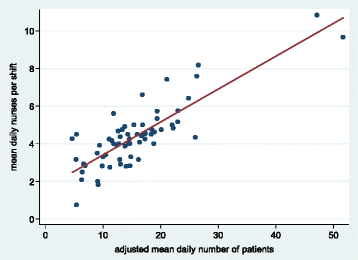Work environment, volume of activity and staffing in neonatal intensive care units in Italy: results of the SONAR-nurse study
- PMID: 27039377
- PMCID: PMC4818898
- DOI: 10.1186/s13052-016-0247-6
Work environment, volume of activity and staffing in neonatal intensive care units in Italy: results of the SONAR-nurse study
Abstract
Background: Neonatal units' volume of activity, and other quantitative and qualitative variables, such as staffing, workload, work environment, care organization and geographical location, may influence the outcome of high risk newborns. Data about the distribution of these variables and their relationships among Italian neonatal units are lacking.
Methods: Between March 2010-April 2011, 63 neonatal intensive care units adhering to the Italian Neonatal Network participated in the SONAR Nurse study. Their main features and work environment were investigated by questionnaires compiled by the chief and by physicians and nurses of each unit. Twelve cross-sectional monthly-repeated surveys on different shifts were performed, collecting data on number of nurses on duty and number and acuity of hospitalized infants.
Results: Six hundred forty five physicians and 1601 nurses compiled the questionnaires. In the cross-sectional surveys 702 reports were collected, with 11082 infant and 3226 nurse data points. A high variability was found for units' size (4-50 total beds), daily number of patients (median 14.5, range 3.4-48.7), number of nurses per shift (median 4.2, range 0.7-10.8) and number of team meetings per month. Northern regions performed better than Central and Southern regions for frequency of training meetings, qualitative assessment of performance, motivation within the unit and nursing work environment; mean physicians' and nurses' age increased moving from North to South. After stratification by terciles of the mean daily number of patients, the median number of nurses per shift increased at increasing volume of activity, while the opposite was found for the nurse-to-patient ratio adjusted by patients' acuity. On average, in units belonging to the lower tercile there was 1 nurse every 2.5 patients, while in those belonging to the higher tercile the ratio was 1 nurse every 5 patients.
Conclusions: In Italy, there is a high variability in organizational characteristics and work environment among neonatal units and an uneven distribution of human resources in relation to volume of activity, suggesting that the larger the unit the greater the workload for each nurse. Urgent modifications in planning and organization of services are needed in order to pursue more efficient, homogeneous and integrated regionalized neonatal care systems.
Keywords: Infant, Newborn; Intensive Care Units, Neonatal; Nurse-Patient Relations; Patient Acuity; Workload.
Figures
References
Publication types
MeSH terms
LinkOut - more resources
Full Text Sources
Other Literature Sources
Miscellaneous


